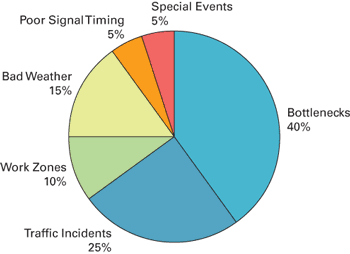Transit and Congestion Pricing
The Traffic Congestion Problem
Costs of Traffic Congestion
Demand for highway travel by Americans continues to grow as the population increases, particularly in metropolitan areas. Construction of new highway capacity to accommodate this growth in travel has not kept pace. Between 1980 and 1999, route miles of highways increased by 1.5 percent, whereas vehicle miles of travel increased by 76 percent. According to the Texas Transportation Institute, in 2003, congestion in the top 85 U.S. urban areas caused 3.7 billion hours of travel delay and 2.3 billion gallons of wasted fuel, for a total cost of $63 billion. This figure would be substantially higher (perhaps three times the amount) if it accounted for the significant cost of growing system unreliability and unpredictability to drivers and businesses, the environmental impacts of idle-related auto emissions, or high gasoline prices. In the 10 most congested areas, each rush-hour traveler “pays” an annual “congestion tax” of between $850 and $1,600 in lost time and fuel and spends the equivalent of almost 8 workdays each year stuck in traffic.
Trends
Highway congestion has increased over the past 2 decades. Between 1982 and 2003, U.S. highway congestion has increased in extent, duration, and intensity. In 2003, in the largest U.S. cities, highway congestion:
- Impacted 67 percent of travel (up from 33 percent in 1982),
- Lasted 7 hours per day in duration (up from 4.5 hours in 1982), and
- Added an additional 37 percent to the length of the average rush-hour driver’s trip (up from 13 percent in 1982).
Congestion also is growing rapidly in small- and medium-sized metropolitan areas. On the basis of current trends, a medium-sized city should expect its congestion in 10 years to be as bad as or worse than that currently experienced by a large city. The rate of congestion growth has been greater in rural than in urban areas, portending increased congestion in communities of all sizes.
Causes of Congestion
Congestion results when traffic demand approaches or exceeds the available capacity of the system. Although this is a simple concept, it is not constant. Traffic demands vary significantly depending on the season, the day of the week, and the time of day. In addition, the capacity, often mistaken as a constant, can change because of weather, work zones, traffic incidents, or other non-recurring events. About half of congestion is caused by temporary disruptions that take away part of the roadway from use, that is, nonrecurring congestion.
 Pie Chart. Causes of congestion (by percentage). Pie chart depicts the following causes of congestion: 40% from bottlenecks, 25% from traffic incidents, 10% from work zones, 15% from bad weather, 5% from poor signal timing, and 5% from special events.
Pie Chart. Causes of congestion (by percentage). Pie chart depicts the following causes of congestion: 40% from bottlenecks, 25% from traffic incidents, 10% from work zones, 15% from bad weather, 5% from poor signal timing, and 5% from special events.
Causes of congestion (by percentage).
Roughly half of the congestion experienced by Americans happens virtually every day—it is recurring. This is the type of congestion in which there are simply more vehicles than there is roadway. Recurring congestion occurs during peak-travel periods for a simple reason: The number of vehicles trying to use the highway system exceeds the available capacity. Effectively managing demand during peak periods involves convincing travelers to make their trip at a less-congested time, on a different mode, on a less-congested route, or through a means other than travel on the highway system (e.g., telecommuting).
When searching for a solution to the congestion problem, most people immediately think of adding a new lane to an overburdened highway. Construction costs for adding lanes in urban areas average $10 million per lane mile. In general, the funding for this construction comes from the tax that drivers pay when buying gas for their vehicles. This amount is insufficient to pay for the lane addition. The bargain price paid by motorists for use of expensive new capacity encourages more drivers to use the expanded highway.
Introducing congestion pricing on highway facilities would discourage overuse during rush hours by motivating people to travel by other modes, such as carpools or public transportation, or by traveling by automobile at other times of the day.